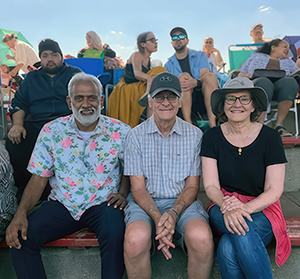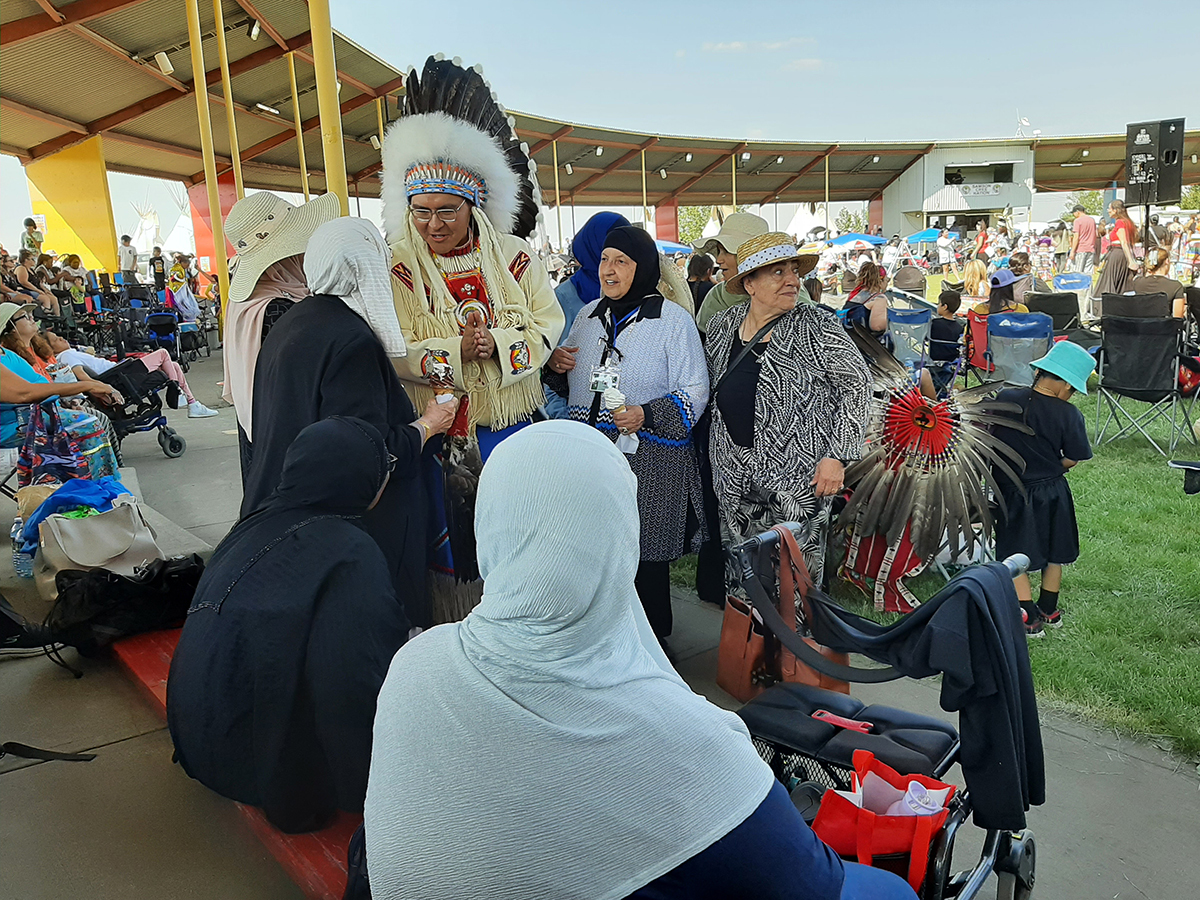
August 20th"Miyo-Wîcêhtowin" -- “Good relations”
For the last two years, A Common Word Alberta (ACWAB) Interfaith participants have been focusing on what it means to build good relations with our Indigenous neighbours. Building good relations is the cornerstone of our collective work of reconciliation. Reconciliation offers all of us the possibility to heal from the historic trauma of settler colonialism through the Truth and Reconciliation 94 Calls to Action. And showing up in Indigenous spaces as good guests, I believe, is the heart of this work.
On Saturday August 10, a busload of Edmontonians set off from Al Rashid mosque headed for the Samson Cree Nation Powwow in Bear Park on Maskwacis Reserve. The bus included members of the Wednesday seniors women’s group from Al Rashid Mosque, along with a few Mennonites from A Common Word Alberta, someone from the Edmonton Interfaith Council, and several Indigenous Edmontonians who heard about our planned outing. Salwa Khadri and I – both members of the ACWAB planning committee organized this, inspired by Al Rashid Outreach Imam Sadique Pathan. At the conclusion of our 2022 ACWAB annual dialogue that explored what our scriptures teach us about reconciliation with the Indigenous in Canada, he said “we should plan an outing to Maskwacis to build a relationship.”
Not everyone on this bus was completely clear on where we were going. One woman thought she was going to an Indian gathering – with Hindus. But all were up for an adventure with a curious and open mind.
When we show up as guests in someone else’s culture and ceremony, it is important to have a good orientation. As we were travelling together on the bus, we explored the context, history and culture of the Powwow. We began with the realization that: if we are not indigenous, we are settlers. We talked about what Powwow means: a gathering to honour ceremony and celebrate Indigenous culture and the various tribes from across the continent that come together. We also talked about some of the protocols such as standing for the grand entry, asking permission to take photos of individuals, and honouring with respect the stories and histories of the beautiful regalia worn by the dancers.
We remembered together that public powwows are still relatively recent history: as recently as 1950, organizing a Powwow was a criminal offence in Canada. This ban was lifted in 1951.
Powwows are indeed a gathering! We gather in a circle to honour the contribution of drummers, dancers, elders, and community leaders. They play a role in our collective healing – healing of relationships and healing of the earth.
It seems that a Powwow inevitably includes an unexpected reunion of people. For me and Don Baergen from Holyrood Mennonite, we had the joy of reconnecting with former colleagues the Edmonton Mennonite Centre for Newcomers (now called Newcomer Centre). What an unexpected reunion that was!
Two of the members of the Al Rashid women’s group were part of a daycare, and knew there might be a young dancer who used to be in their daycare. And sure enough, that reunion happened as well.
I was curious to know how the Al Rashid women felt about their experience, and so joined them for their regular Wednesday meeting a few days after this outing, and here are their reflections.
- “The Indigenous have a nice culture. We felt very welcomed. We were even invited to come again [by an Indigenous dancer who spoke some Arabic].”
- “It is important for us to join their special traditions. We care about all people.”
- “We always learn something new: when the Buffalo family paraded holding a memorial that represented the survival of their family’s genocidal history, we learned that it is not respectful to take photos.”
- “It was so good to see that Indigenous people have their rights now. There is hope that [my] Palestinian [people] will get their rights too.”
One participant had read stories about the Inuit in history books when she was young in her home country of Syria. She took pictures at this Powwow and sent them back to her son who is still in Syria and who is a teacher. She was so happy to have a real, live experience of Indigenous culture.
One woman was so pleased and happy that so many knew about Middle Eastern and Muslim culture. “They were familiar with Islam!”, she said. There was mutual respect for different cultures in this space.
In 2017, I was part of the planning team between Bent Arrow Traditional Healing Society and EMCN to bring Indigenous knowledge of ceremony into newcomer language (ESL) classes. The planning team all got sweatshirts to celebrate this work together. The back of the sweatshirt says, "Miyo-Wîcêhtowin". This translates as “Good relations.” As settlers on Treaty Six land, we are invited to ensure that all of our connections with each other contribute to “Good relations.” This outing definitely captured the spirit of Miyo-Wîcêhtowin. Hai Hai.

Photo credit: Suzanne Gross